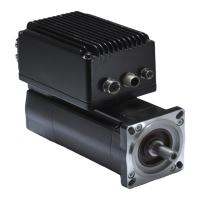PROFIBUS connection Page 25
PROFIBUS-Manual Servo positioning controller DIS-2 48/10 FB Version 2.0
5.2 Slave overview
This section provides an overview of slave-related steps for parameterisation and configuration. As
some parameters do not become effective until after storage and reset, the following procedure is
recommended:
1. Telegram configuration using the Telegram editor, chapter 6
2. Selection and parameterisation of Physical units, chapter 7
3. Configuration and activation of Operating parameters, chapter 8
The meaning of the data at the slave end is defined by entering parameter numbers (PNUs). This is
done with the help of the telegram editor of the DIS-2 ServoCommander
TM
parameterisation program.
The number of bytes for the PNU is automatically displayed. As a reference, the telegram editor also
displays the total length of the telegram.
Important process data with regard to position, speed and acceleration are handed over in the form of
physical units. These units should be parameterized prior to starting the communication as they
define the way the data are interpreted in the servo positioning controller.
Once these steps have been completed, the operating parameters of the PROFIBUS connection
have to be set. The slave address has to be set correctly prior to activating the communication.
Additional options for controlling the address allocation can be activated through an external
connection.
5.3 Master overview
This section provides an overview of master-related steps for parameterisation and configuration. The
following procedure is recommended:
1. Installation of the GSD file
2. Indication of the slave address
3. Configuration of the input and output data
At the master end, the servo positioning controller has to be integrated into the PROFIBUS. To do so,
the GSD file has to be installed if this has not been done already. Then the address for the slave and
the input and output data have to be configured.
This is now described as an example for the integration under SIEMENS SIMATIC S7.

